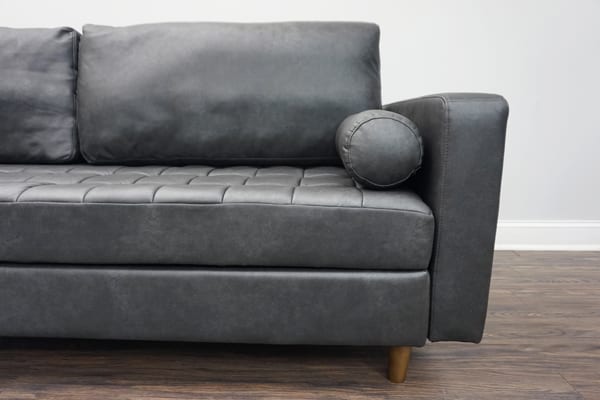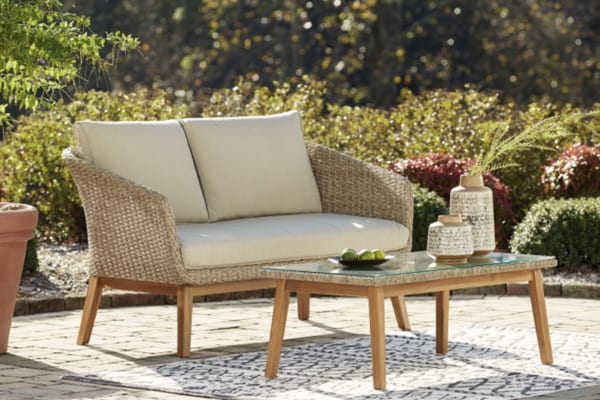As the temperature begins to drop, it's time to prepare your beloved furniture for the frosty, brisk, and dusty air. This chilly, parched season can pose significant threats to your furniture's stability and aesthetics. This makes it essential for you to invest time in proper maintenance and care. To help you keep your furniture looking great and lasting through the frost, we’ve gathered some expert advice from the pros at Furniture Mecca. Get ready to protect your furniture from the harsh winter elements with these helpful winter furniture care tips and tricks.
One essential tip for safeguarding your furniture is to keep it away from direct heat sources. Whether it’s upholstered pieces or wooden furniture, placing them too close to radiators, space heaters, or fireplaces can cause damage over time. The heat can lead to color fading, loss of elasticity in fabric, and cracking in wooden and glass items.
Same with the plastic and metal furniture items. Metallic furniture can lose its paint and structural integrity with heat absorption resulting in expansion, warping, fades, and peels. Direct heat exposure can also damage your plastic furniture causing it to warp and even melt in some cases. Avoiding these heat sources is a simple yet effective way to protect your cherished furniture from excessive dryness.

Dry, frosty air can compromise your furniture's integrity, leading to issues such as drying, fading, shrinking, and brittleness. The only way you can combat this issue is by maintaining proper humidity levels in your home. You can do this by installing home humidifiers to maintain a certain temperature for winter furniture care.
Installing a whole-house humidifier may be costly for those on a budget, but there are effective alternatives. You can place a basin of water or a damp towel near a heating source to effectively release moisture into the air. Alternatively, a portable humidifier can be an occasional solution to keep the atmosphere comfortable for your furniture.
Just as protecting upholstery is vital, polishing your wooden and metallic furniture cannot be overlooked. The dry winter air and indoor heating can cause cracks and warps, diminishing the beauty of your wooden pieces, particularly if they are made from engineered timbers. As for the metal furniture and metallic hardware like sofa feet, knobs, or decorative trims, polishing creates a protective layer. It shields against seasonal damages like contraction, weakening, paint peeling, and brittleness.
Polishing offers both practical and aesthetic benefits: it helps prevent damage while restoring the natural luster of your furniture. With regular polishing, you can preserve the beauty and lasting quality of your wood and metal items throughout the season.

While you may be accustomed to winter furniture care for outdoor pieces, it's equally important to clean your indoor pieces during cold season. This season sees an increase in dust and allergens trapped in furniture. This happens due to more time spent indoors and the dry air that allows dust to circulate more freely. In winters people tend to stay indoors for the heating benefits and cleaning your space on a daily basis helps prevent dust-related damages.
Regular cleaning not only removes dust buildup but also helps reduce the risk of bacteria and allergies in your home. Prioritizing this upkeep is vital for maintaining your furniture as well as healthy living environment.
Leather, while known for its wintry allure and aesthetic, is not immune to the dryness of winter. Cold air can make your leather furniture lose its charm with cracking, stiffness, and dullness. Conditioning is the best safeguard against these issues. Invest in high-quality leather conditioning creams or balms, and consider expert-recommended options like neatsfoot oil or mink oil. For a homemade solution, olive oil, coconut oil, or beeswax can be effective. Conditioning your leather pieces will maintain it’s natural beauty, prevent dullness, and extend its lifespan by making it more resistant to stains and damage.

Here is yet another winter furniture care tip for your upholstered items. To preserve the durability of your upholstery during winter, utilizing a good-quality fabric protector is key. Fabric protectors repel moisture and reduce static buildup in your upholstered furniture, which can be uncomfortable in dry conditions. It also prevents dirt from settling into your furniture while effectively resisting stains and spills. Look for protectors made specifically for your upholstery materials and choose non-toxic options if you have pets or children. Remember, it's best to thoroughly clean your furniture before applying any protectant to ensure a smooth application that lasts long.
Covering your outdoor furniture is perhaps the most effective winter furniture care tip to shield it from seasonal damage. The dry and harsh winter environment can severely impact the stability and integrity of your furniture. To protect it, use covers made from weather-resistant fabrics that can endure rain, snowfall, and hail. Look for materials that effectively repel moisture and liquids to minimize the risks of dampness and molding.
If feasible, consider having your furniture covers tailored specifically to your furniture dimensions to fit them perfectly. Secure them with straps or ropes to prevent cover from slipping or blowing away. This will safeguard against freezing, drying, rusting, and cracking in wooden and metal pieces. This method also works wonders for plastic furniture, helping it retain its shape and original color.

If you live in an area that experiences winter snow, this tip may be especially relevant for you. Instead of simply leaving your outdoor furniture covered, take the time to maintain it even when it’s not in use. Regularly shoveling snow off your furniture can help prevent the build-up of ice, risky for its quality and longevity. Excess snow can trap moisture and create excessive weight, leading to potential long-term damage.
Moisture accumulation in outdoor furniture can result in mold, mildew, and problems like swelling or shrinkage. The weight of heavy snow can also cause your furniture to freeze, stiffen, warp, bend, or break. By shoveling snow routinely, you can significantly reduce or even eliminate these risks.
In harsh winter conditions, merely covering your outdoor furniture is not enough. To ensure it can withstand the challenges of winter, including moisture from rain and snow as well as the dry air, use a furniture sealant. Invest in a high-quality sealant designed for outdoor furniture materials like wood, wicker, or metal. Before applying, ensure your furniture is thoroughly cleaned and completely dry.
If the weather becomes particularly severe, don’t hesitate to reapply the sealant to maximize its protective benefits. Using protective sealant can prevent moisture-related damage, stopping issues like mold in wood, rust in metal, and deformation in plastic. Likewise, it provides protection against dry weather, helping combat problems like cracking, warping, and brittleness in various materials.
The simplest and most effective winter furniture care strategy for protecting your outdoor items is to bring them indoors. The garage is the best option since it provides shelter without taking up valuable living space. If you lack a garage, consider basement or attic, where your furniture will stay safe from the cold. However, if those areas are damp or filled, the mudroom or a guest room can serve as practical storage spots.
Mudrooms typically have lower traffic, making them ideal for storing outdoor furniture. An unoccupied guest room is also a good choice, as it won’t be disturbed frequently. If needed, you can utilize closets or hallways, ensuring that your furniture is out of sight.
When storing your patio or backyard furniture indoors, keep several important tips in mind:
• Use slip covers on your outdoor furniture if you’re not planning to use it soon inside your house.
• Prior to bringing your furniture inside, it’s essential to clean it thoroughly, as outdoor items can harbor dirt and allergens.
• Properly dry your furniture before storing it to prevent moisture-related damage like swelling, shrinkage, and mold.
• Inspect your furniture for any pre-existing damage when cleaning, focusing on wooden pieces for cracks, splits, or mildew.
• If possible, disassemble your furniture before storage to make it easier to handle and minimize the space required.
• Ensure adequate ventilation wherever you store your furniture; a poorly ventilated area may lead to further damage over time.
By following these straightforward winter furniture care tips, you can ensure that your cherished pieces remain in excellent condition throughout the colder months. Embrace the season fully, knowing your furniture is well cared for!
